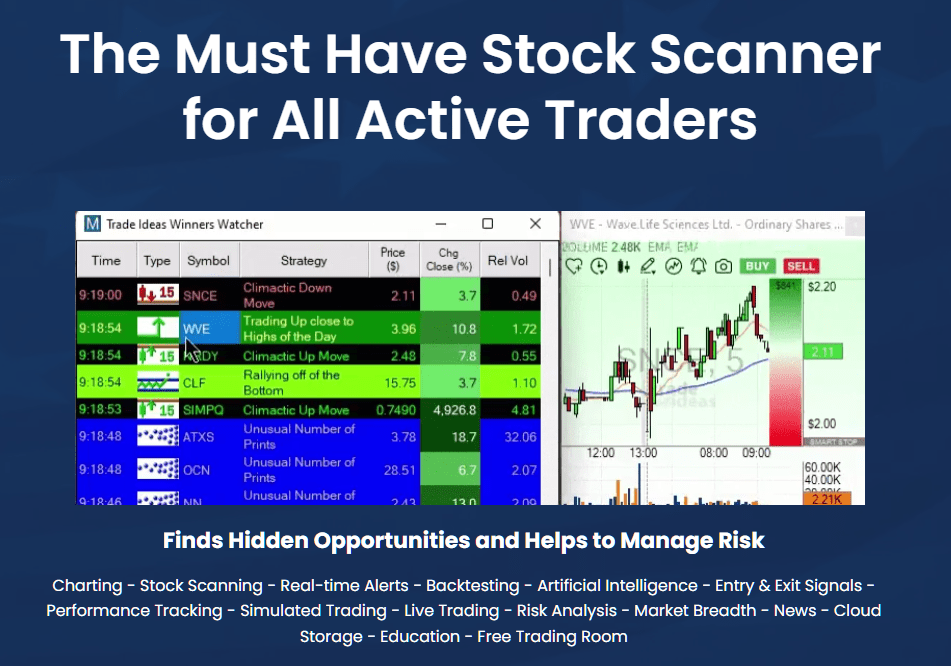20 Free Suggestions For Picking AI Stock {Investing|Trading|Prediction|Analysis) Websites
20 Free Suggestions For Picking AI Stock {Investing|Trading|Prediction|Analysis) Websites
Blog Article
Top 10 Ways To Assess The Market Coverage Provided By Ai-Based Stock Predicting/Analyzing Platforms
When looking at AI trading platforms that predict/analyze the market, coverage of the stock is an important factor to think about. It determines what types of assets and markets are available. A platform with extensive market coverage will allow investors to diversify their portfolios, explore global trading opportunities and adapt to different strategies. These are the 10 best tips for evaluating the market coverage provided by these platforms.
1. Evaluate Supported Asset Classes
Stocks - Check that the platform is able to provide coverage of the major stock markets (e.g. NYSE NASDAQ LSE HKEX) as well as includes mid-caps, small-caps, and large-caps.
ETFs Make sure the platform allows you to select from a wide range of ETFs. This can provide you with a variety of exposure.
Futures and options. Make sure the platform includes derivatives like options, futures, and other instruments leveraged.
Forex and commodities: Find out whether your website offers commodities and forex, precious metals and energy commodities.
Cryptocurrencies: Check if the platform supports major copyright (e.g., Bitcoin, Ethereum) and altcoins.
2. Check Geographic Coverage
Global markets - Make sure that the platform can to serve all major markets around the world including North America (including copyright), Europe, Asia-Pacific markets as well as emerging ones.
Regional focus Verify that the platform is specialized in specific regions or markets that align with your trading interest.
Local exchanges. Determine whether the platform permits regional or local exchanges relevant to your geographic area or business plan.
3. Compare real-time data with delayed Data Delayed Data
Real-time data: Ensure that the platform is able to provide real-time market information to make quick decisions, particularly for active trading.
Delayed data: Find out if you can get delayed data for no cost, or at a lower cost. This might be enough for long-term investors.
Data latency: See whether the platform reduces latency for data, particularly in high-frequency trading.
4. Review the Historical Data available
The depth of historical data Check that the platform provides extensive historical data that can be used for backtesting analysis, testing and analysis (e.g. 10or more years).
Check the level of granularity in historical data.
Corporate actions: Verify if historical data accounts for dividends, stock splits as well as other corporate actions.
5. Verify Market Depth and Order Book Information
To get a better price Make sure the platform is equipped with Level 2 data.
Verify that your platform is showing live price spreads.
Volume data: Make sure that the platform offers specific volume data that can be used to study market liquidity.
6. Examine the your coverage of Indices & Sectors
Major indices : Ensure you are using a platform that contains the major indices. (e.g. S&P 500, NASDAQ 100, FTSE 100 ) This is crucial for benchmarking as well as index-based strategy.
Data from specific sectors to perform a focused analysis, determine if the platform has information for specific sectors (e.g. health care, technology, etc.).
Custom indices. Check if your platform allows you to create and track custom indexes based on the criteria that you define.
7. Examine the integration with Sentiment and News Data
News feeds : Ensure you have a platform that allows live news feeds, preferably from reliable media sources (e.g. Bloomberg and Reuters), for the most significant market events.
Sentiment Analysis: Check if the platform offers tools for analyzing sentiment that are made from news, social media or other data sources.
Event-driven strategies (e.g. earnings announcements or economic reports): Check if your platform allows trading strategies based on events.
8. Check for Multi-Market Trading Ability
Cross-markets trading: The platform should permit trading across multiple markets or asset classes using a single user interface.
Currency conversion: Check if your platform allows multi-currency trading and automated currency conversion.
Support for time zones: Check if your platform allows you to trade in different time zones.
9. Review the coverage of other sources
Alternative data: See whether the platform incorporates other sources of data (e.g., satellite imagery internet traffic, credit card transactions) for unique insight.
ESG data: Determine whether the platform contains environmental, social, and governance (ESG) information to support socially responsible investing.
Macroeconomic data: Ensure that the platform provides macroeconomic indicators (e.g. inflation, GDP, or interest rates) to conduct a fundamental analysis.
Examine the Feedback of Users and Market Reputation
User feedback is a fantastic method to assess the market reach of a platform.
Reputation in the industry: Find out whether the platform is regarded for its market coverage by experts in the industry or awards.
Testimonials and case studies: These will highlight the performance of the platform in particular market segments or asset classes.
Bonus Tips
Trial period - Use the demo or trial version for free to test the coverage of data and market coverage.
API access: Check if the platform's API allows access to market data in a programmatic manner for customised analysis.
Support for customers: Make sure whether the platform has support for queries related to markets or data.
These suggestions will allow you evaluate the market coverage offered by AI trading platforms which predict or analyze price movements of stocks. This way you'll have the ability select the one that gives you the information and markets you need for successful trading. Comprehensive market coverage lets you to diversify your portfolio and discover the possibilities of your portfolio. It also helps you adjust to changes in the market. Check out the top ai stock market url for website examples including trader ai, ai investing, ai stock price prediction, ai stock, incite, ai trading platform, ai trading software, ai hedge fund outperforms market, ai based trading platform, copyright financial advisor and more.
Top 10 Ways To Evaluate The Regulatory Compliant Of Ai Stock Analysis And Prediction Platform
The regulatory compliance aspect plays an important part in the evaluation of AI platforms for analysis and prediction of stocks. Compliance ensures that a platform complies to financial regulations, and adheres to legal frameworks and protecting user information. This minimizes the chance of legal or financial concerns. Here are 10 top ways to evaluate the compliance with regulations of these platforms:
1. Check your license and registration
Regulators: Make sure the license and registration is registered with the relevant financial regulators (e.g. SEC or FCA in USA, ASIC or ASIC in Australia).
Check that the brokers included in the platform are licensed and licensed and.
Public Records: Check out the website of your regulator body to find out information about the status of registration or past violations, as well as other pertinent information.
2. Measure Data Privacy Compliance
GDPR: If operating or serving users within the EU make sure the platform meets the requirements of the General Data Protection Regulation (GDPR).
CCPA For Californian users Check compliance with California Consumer Privacy Act.
Data handling policies: Read the data privacy policy of the platform to find out the way it describes data collection, storage, and sharing.
3. Examine Anti-Money Laundering(AML) Measures
AML policies: Ensure that your platform is equipped with a robust AML policy that can detect and stop any laundering of money.
KYC procedures: Check that the platform adheres to Know Your Customer (KYC) procedures to verify identity of the user.
Check the platform's transaction monitoring. Does it monitor transactions and report any suspicious activity to the authorities?
4. Check to see if you are in compliance with Trading Regulations
Market manipulation: Ensure that the platform has measures in place to prevent any market manipulation, such as the spoofing of trading or wash trading.
Types of orders: Verify that the platform is compliant with the regulations applicable to different types of orders (e.g. no illegal stop-loss hunt).
Best execution: Check to see if the platform adheres best execution practice, which ensures that trades are executed at the lowest price.
5. Cybersecurity compliance assessment
Data encryption: Ensure that the platform protects data during transit and while at rest, using encryption.
Response to incidents. Verify whether the platform has a strategy of action for handling data breaches and cyberattacks.
Certifications: Make sure the platform holds cybersecurity certifications (e.g., ISO 27001, SOC 2).
6. Transparency & Disclosure:
Fee disclosure: Make sure the website discloses all fees including hidden or additional fees.
Risk disclosure: Verify if the platform provides explicit risk disclosures, particularly for leveraged or high-risk trading strategies.
Performance reporting: Ensure that the platform produces transparent and accurate performance data to its AI model.
7. Check the Compliance to International Regulations
Cross-border trading. If you plan to do international trading, ensure whether your platform is compliant with all regulations applicable to it.
Tax reporting: Find out if a platform has tools or reports to allow users to follow tax regulations.
Sanctions compliance: Make sure the platform adheres to international sanctions and does not allow trading with prohibited entities or countries.
8. Examine Record-Keeping and Audit Trails,
Transaction records: Ensure that the platform keeps complete records of each transaction to ensure audit and regulatory compliance.
Logs of user activity: Check if your platform records all activity of users, like logins, transactions, and adjustments to settings for accounts.
Audit readiness: Ensure that the platform can supply all the necessary documents and logs in the event of a regulatory audit occurs.
9. Evaluation of Compliance with AI Specific Regulations
Algorithmic Trading Rules If your broker supports algorithmic trading, ensure it is compliant with the rules such as MiFID II (in Europe) or Reg SCI (in the U.S.).
Fairness and bias: Check whether the platform modifies or is monitoring its AI models to ensure ethical and fair trading.
Explainability. Some regulations may need the platform to describe AI-driven predictions and decisions.
10. Review User Comments as well as Regulatory Historical History
User reviews: Study user feedback to gauge the platform's reputation for regulatory conformity.
Check the history of regulatory compliance to determine whether any violations of the regulations were committed, and also fines and penalties.
Third-party inspections: Determine if the platform is subjected regularly to third-party inspections by a third party to ensure compliance.
Bonus Tips
Legal consultations: You may consider consulting an attorney to determine if the platform is in compliance with applicable regulations.
Trial period. Try the trial or demo version of the platform to try out its compliance features.
Customer Support: Make sure that the platform has customer support for any queries or problems related to compliance.
If you follow these guidelines, you can effectively assess the compliance with regulations of AI platforms for stock prediction and analysis, ensuring you choose one that adheres to legal guidelines and protects your rights. Compliance is crucial as it does not just reduce the risk of legal liability, but also builds trust and confidence for the platform. Follow the top copyright ai trading bot tips for site tips including ai trading, ai trading bot, trader ai app, trading ai, copyright ai trading bot, best ai etf, ai trading, best ai trading app, ai trader, ai trading software and more.